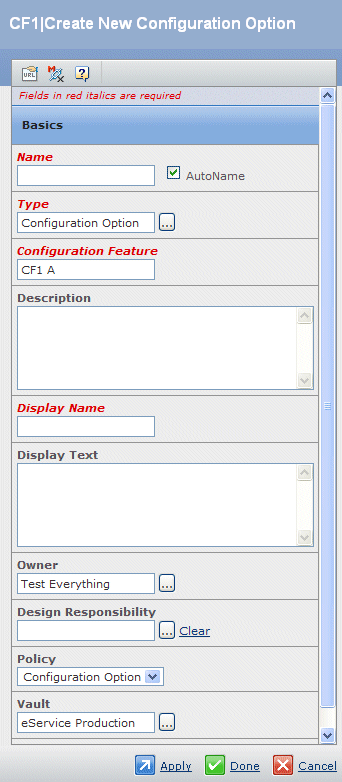Creating a Configuration Option | ||||||
|
| |||||
To create a configuration option, do one of the following:
- From the global My Enovia
 menu, under Variant Configuration, select Configuration Features. In the Configuration Features page, select a configuration feature, click Enable Edit, then from the page Actions menu, select Create Configuration Option.
menu, under Variant Configuration, select Configuration Features. In the Configuration Features page, select a configuration feature, click Enable Edit, then from the page Actions menu, select Create Configuration Option. - From the global Actions
 menu, under Variant Configuration, select Create Configuration Option.
menu, under Variant Configuration, select Create Configuration Option. - In the context of a product line, from the Categories menu, select Configuration Features. In the Configuration Features page, select a configuration feature, click Enable Edit, then from the page Actions menu, select Create Configuration Option.
- In the context of a product, from the Categories menu, select Configuration Features. In the Configuration Features page, select a product, click Enable Edit, then from the page Actions menu, select Create Configuration Option.
- In the context of a product variant, from the Categories menu, select Configuration Features. In the Configuration Features page, select a product variant, click Enable Edit, then from the page Actions menu, select Create Configuration Option.
- In the context of a configuration feature, from the Categories menu, select Configuration Features. In the Configuration Features page, select a configuration feature, click Enable Edit, then from the page Actions menu, select Create Configuration Option.
In all cases except from the global Actions menu, a Create New Configuration Option slide-in window opens on the right side of the screen. In the case of the global Actions menu, a popup window opens.

- From the global My Enovia
Edit the fields as follows:
- Name
- This field is required. Uncheck the AutoName check box to enable the Name field for editing. Leave the box checked if you want to allow the system to assign a name automatically.
The following special characters are prohibited in names.
Special Character Description @ Commercial At Sign , Comma * Asterisk ? Question Mark [ Left Square Bracket ] Right Square Bracket # Number Sign $ Dollar Sign { Left Curly Bracket } Right Curly Bracket \ Backslash " Double Quotation Mark < Less-Than Sign > Greater-Than Sign | Vertical Line % Percent Sign ; Semicolon & Ampersand = Equals Sign Note: If you should need to use any of these special characters in a name, you can edit the emxFramework.Javascript.NameBadChars property in the emxSystem.properties file located in SERVER_INSTALL\managed\properties\ (Windows) or SERVERHOME/managed/properties/ (UNIX).
- Type
- This field is required. The default type is Configuration Option.
- Confguration Feature
- Association of the configuration option with a configuration feature is required.
- If the page was invoked outside the context of a configuration feature, click
 to select a configuration feature.
to select a configuration feature. - If the page was invoked from within the context of a configuration feature, that configuration feature is displayed and this field is read-only.
- If the page was invoked outside the context of a configuration feature, click
- Description
- Enter a description for the new configuration option.
- Display Name
- This field is required. The default is the same text that was entered in the Name field. See above for rules regarding use of special characters.
- Display Text
- Enter any text to be displayed together with the configuration option.
- Owner
- The default owner is the current user. Click
 to select a different owner.
to select a different owner. - Design Responsibility
- Enter the Responsible Design Organization (RDO) for the configuration option. Click
 to select an RDO from a list of available organizations. Click Clear to erase the field and start over. The default design responsibility is based on the context. If there is no context (i.e., the page was accessed from the global MyEnovia or Actions menu), then this field is initially blank.
to select an RDO from a list of available organizations. Click Clear to erase the field and start over. The default design responsibility is based on the context. If there is no context (i.e., the page was accessed from the global MyEnovia or Actions menu), then this field is initially blank. - Policy
- The policy (lifecycle) is that defined for a Configuration Option object. This cannot be changed.
- Vault
- The vault in which the new configuration option will be created is displayed. Click
 if you want to select a different vault.
if you want to select a different vault.
Click Done to save your selections.
If any required field is not filled in, an error message is displayed instead and control is transferred to that field where you must provide the missing information.